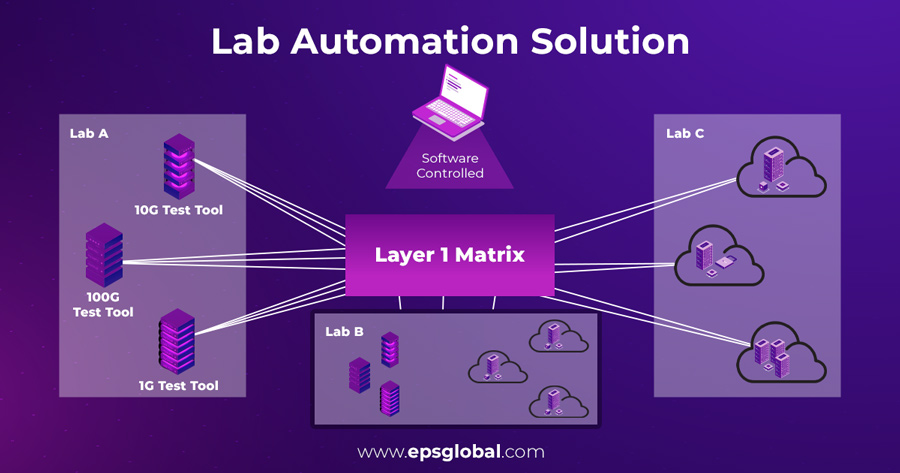
In pandemic environments like COVID-19, having a lab automation solution to remotely setup & configure lab networks is a key tool for business continuity. However the benefits do not end there, as a test lab automation solution reduces testing costs while at the same time accelerating the introduction of new products and services - providing measurable value to the business.
In this webinar we reviewed how to automate your hardware test lab so it can be managed remotely 24/7 from anywhere in the world via a novel, software-defined and non-blocking layer 1 switching matrix based on disaggregated switching platforms. This highly innovative and cost-effective approach to test lab automation uses commodity white box Ethernet switches to deliver a flexible and scalable VirtualWire fabric for software defined test lab automation.
Challenges of Traditional Labs
The frequent re-wiring of lab resources and network topologies is manual, error prone, and time consuming. Underutilized and expensive lab resources can often be located in lab silos around the company, yet multiple teams are vying for access, Engineering teams of course, who need to test updates, patches and develop new products; Support teams who need to replicate customer issues in order to debug; Technical Sales teams who need to set up topologies for customer PoCs; and Sales for demos. Even if these non-negligible challenges weren’t in existence, the most glaring issue facing Lab Managers today is that a traditional lab requires continuous physical lab access, which is something that has been tenuous, if not impossible at times during the past year of our pandemic-hit world.
What does Lab Automation do for you?
Layer-1 automation solutions mean you can wire once, and then re-wire in the software which eliminates the manual, error-prone changes we mentioned earlier and enables extensive automation of test environments.

Lab automation allows you to maximize utilization and the sharing of expensive test equipment and traffic generator ports across teams, projects and even different labs which is practical and cost-saving. While a vast majority of the global working population is working from home, including Data Center Engineers (we found ourselves frequently shipping gear to home addresses in the past 12 months, something unheard of before!), the ability to remotely manage the lab 24x7 from anywhere in the world is a massive plus.
6 Reasons Why Pluribus’ Solution Makes Sense
Pluribus Lab Automation delivers immediate value, and is particularly relevant in pandemic environments. You can:
- Save time by automating and simplifying configurations.
- Reduce costs and optimize resources, for example, test generators, allowing expensive test equipment to be shared across teams.
- Reduce errors - cable once and re-wire in software – Pluribus’ catchy mantra.
- Increase capacity and scale the lab on-demand.
- Automate and manage your lab remotely 24/7 - no more call outs to the office on a Friday night as you're sitting down to your takeout.
- Get products and services to market faster as your release cycle is shorter.
Click here to find out more about Pluribus Networks’ solutions.
Webinar Q & A
What are the benefits of stretching one Layer 1 fabric across multiple labs versus a Layer 1 fabric at each lab, in addition to the policies benefit?
If you have a chassis in every single lab, there are two issues.
- Expansion becomes a nightmare. You have several racks and you need to expand at some point, but you cannot interconnect the devices anymore because now you have a new Layer 1 chassis and these two cannot talk to each other which introduces inefficiencies.
- The second is regarding sharing the traffic generated resources. To give you a real-life example, we were working on a PoC and we wanted Spirent traffic generator (at Pluribus we use Ixia) to replicate what the customer needed from a remote location, it was not in the Pluribus lab. It was during the very initial days, before we had even implemented Layer one in our own lab. We had to ship the entire Spirent chassis which took a week or so, and it's expensive because they are large, we had to wait for it to arrive, then do the testing and ship it back, all of which took time. If I had a Layer 1 solution, I wouldn’t have the same cost and time considerations, I could simply make the connection remotely and it would be done. Expanding your Layer 1 connectivity across labs is going to future-proof your set up, even if you don’t see it right now, labs are always expanding.
What is the minimum latency required for connectivity between locations?
There is no minimum latency required. If I have them on two different locations the latency is going to be high, and I have only a certain amount of time to make the connection it' could be an issue. For the endpoint connectivity there are two types - tracking and no tracking of the link state.
When you have tracking enabled, it sends proprietary keep-alive messages every x amount of time which is configurable, so if I have it on two different locations I can just increase the timeout time on the timer, which will ensure that you are not going to see a false down and bring its own code down.
Can the switch operate in hybrid mode meaning you can use as a regular switch and use it for cloud connectivity?
Yes, that's the beauty of the Pluribus Layer 1 lab automation solution. The user can purchase a single switch for lab automation and once they are familiar with the solution, they can actually simply disaggregate it and simplify their network because the hybrid model is supported. You don't need two different switches, you can have a few ports designated to do the lab automation and Layer 1 endpoint connectivity, and you can have the rest of the ports for regular L2 to L3 connectivity, managing the regular network communication.